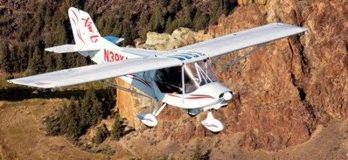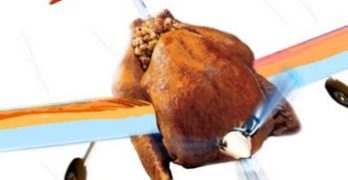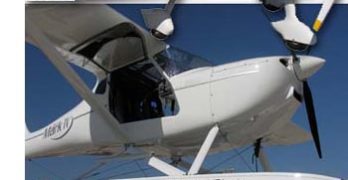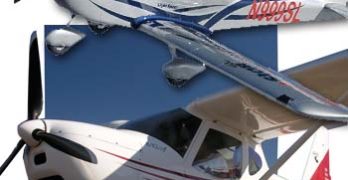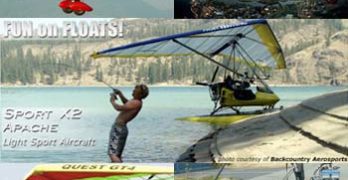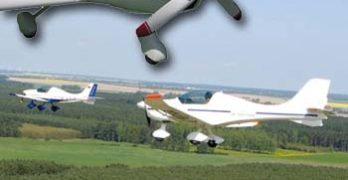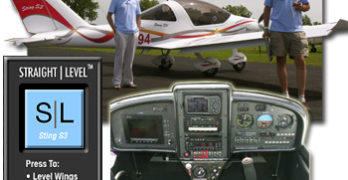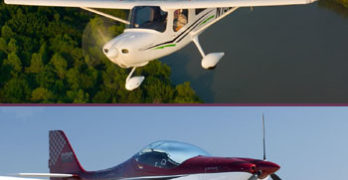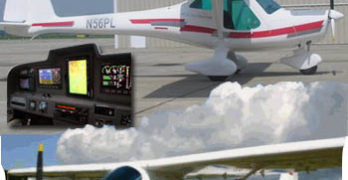Holy Economics 101, Batman! *** X-Air LLC just sent out a release that caught my eye. *** X-Air is the Bend, Oregon-based LSA manufacturer that makes an ultralight-style flivver directly targeted at those recreational flyers and wingabees (flight-dreaming wannabes, get it?) on a tuna sandwich budget. *** The tube-and-fabric, fun-flying X-Air LS has a lot to offer for those less concerned with high-bucks style and more motivated by low-cost substance, in this case saving the Benjamins during flight training. *** A new X-Air LS goes for around $60,000 and burns 4 gal/hr! That translates into low-cost flight training, as well as dirt-cheap recreational-flight renting or club/shared ownership flying. *** The basic Sport Pilot license, with the minimum 20 in-flight training hour requirement, is already affordable when compared with a Private Pilot’s license. *** Now, students could find themselves spending 50 clams per hour instead of 200 in a Skyhawk.
Search Results for : Sebring Expo
Not finding exactly what you expected? Try our advanced search option.
Select a manufacturer to go straight to all our content about that manufacturer.
Select an aircraft model to go straight to all our content about that model.
Post-Turkey Day Update
“It’s a bird! It’s a plane! Actually, it’s both…and edible!” *** Fresh but larger in girth from the great American pastime of massive calorie infusions and days of leftovers (turkey sandwich/curried Turkey/cranberry yogurt surprise (don’t ask) etc., let’s see whassup around the old info-hangar. *** Looking to e-gab with other light sport enthusiasts? There are some cool sites around with lots of hands-on topics such as training, maintenance, fun flying and more. Here are a couple I’ve come across that seem well-attended: Sport Pilot Talk and South Africa’s AvCom with a look at Light Sport and GA flying in the southern Hemisphere *** Lots of links here to tons of general LSA sites : Light Sport Aircraft HQ *** Flight training resource guide: Pilot Journey *** Experimental/homebuilt and light sport discussions (Jabiru and Rotax forums here): Wings Forum *** BTW: Sebring’s annual Light Sport Aviation Expo is kicking off Jan.
Dealmaking and Consolidation? New LSA Directions?
What to the following events have in common? …Sebring LSA Expo, Heart of Texas LSA Expo, Midwest LSA Expo, Sport Pilot Tour… Answer: All are focused marketing shows generating keenly interested crowds to examine Light-Sport Aircraft. When that happens, business arrangements sometime result, and not all deals are between airplane buyers and sellers. *** At the Sebring LSA Expo FK Lightplanes USA struck an agreement with Hansen Air Group. The latter, an Atlanta-based national seller of the Sky Arrow and new FP-04 Peregrine, signed on to represent the Fk9, seen in Florida atop Baumann BF-1500 floats. One aviation family helps another as FK’s father-and-son Tony and Adriel Anderson linked up with twin brothers Jon and Ron Hansen. *** Recently I attended an open house for another mini-conglomerate in light-sport aviation based at the Melbourne, Florida airport.
Light-Sport Aircraft… Leading the Way Up?
Sebring was a welcome event for all who participated. Companies that stayed home may be wondering if that was the right move. With record crowds, airplane orders taken, and merchandise selling out, the Florida LSA show gave a welcome lift to a global aviation industry that’s been laying off workers by the thousands. But, besides the general good news I’ve been asked dozens of times, “What was new?” at the event. Here’s my list; details will follow in other SPLOG posts. Surely I’ll leave out some worthy aircraft (you’ll tell me, I hope, and I’ll include them). *** In no particular order…the well-proven RANS S-6 Coyote debuted as an SLSA; Urban Air’s newly certified Samba complements their lovely Lambada; FPNA’s amphibious Cape Town appeared on brand-new floats; Paradise delivered their first hand-control P-1; Remos debuted their GX 2009 with new gear and a redesigned interior; a year after its debut at Sebring ’08 CTLS displayed the first-ever Garmin 696 installation, while the avionics company announced their GDU 370 and 375 MFDs; Evektor showed their SportStar SL with a recontoured exterior; Tony and Adriel Anderson showed their Fk9 on new Baumann amphib floats; they’re teaming up for sales with Hansen Air Group, which also showed a production version of their new FA-04 Peregrine; Zenith Aircraft constantly demo flew the STOL CH-750, an upgrade from their popular 701; Cessna identified notable changes in the final Skycatcher design (a larger tail) and confirmed first deliveries in ’09; and, the K-10 from Ukraine-based Skyeton made its worldwide debut…and made a sale.
Think All Trikes Are Foreign? Think Again!
Weight-shift control LSA, affectionately referred to as “trikes,” are often made overseas. That’s a bit weird as the concept originated in the USA and spread around the globe. Tens of thousands are flying, despite their relative rarity in America. So you could be excused for viewing trikes as foreign. Not all of them… *** Though it won approval last summer, the newest SLSA in the game — we now have 89 models from 67 companies — is the North Wing Design Sport X2, available in two models plus ELSA versions with alternate engines. The Navajo may represent the least expensive SLSA you can purchase, retailing for $29,000 ready-to-fly. An Apache model is more dressed out and runs $32,000, still quite a bargain in today’s world of $135,000 SLSA airplanes. (More price info.) *** North Wing is an all-American company from Washington state making both trike carriage and wings.
Year Ends with New SLSA: Welcome FA-04 Peregrine
On December 29th, a new Special Light-Sport Aircraft was approved. With only a couple days remaining in this challenging year, I suspect this will be the final approval of 2008. Welcome to the FA-04 Peregrine, which was inspected after assembly at Hansen Air Group in the Atlanta area. I believe this to be the first LSA from former East Germany (which was ironically named German Democratic Republic even though it was Communist). *** FA-04 Peregrine is a low-wing carbon fiber LSA that evolved from Flaeming Air‘s FA-02, which earlier had won European VLA approval. The interior is 44 inches wide (a Cessna 172 is 39.5 in.) with “lots of legroom” and a large luggage compartment that makes the model appropriate for longer cross country flights. Adjustable seats aid occupant comfort. In an interesting variation, Peregrine has main landing gear that can “easily be converted to a taildragger,” said Jon Hansen.
Free Straight & Level Button for Sting S3 Owners
Recently I visited Cirrus Design. I saw progress on the Cirrus Vision jet and the new Garmin Perspective panel for the SR22. Both aircraft are full of high-end avionics. *** Down here in the world of Light-Sport Aircraft, we have far less costly choices for flat-screen avionic displays (panels in the Vision or SR22 literally cost more than an entire LSA). Yet the data each set of instruments uses is identical. LSA are also often equipped with autopilots…again, far less expensively compared to the certified units GA builders install. *** Recently SportairUSA announced their new “Straight & Level” button. If you find yourself in the soup unexpectedly, the pilot or passenger can push one button causing the autopilot to take over by guiding the airplane while the occupants assess their next move. It’s a brilliant idea to give pilots a breather. “The Straight and Level system is a significant advance in flight safety for Sting owners,” says Bill Canino, operator of SportairUSA, “That’s why we are providing it at no additional cost on all of ourTruTrak EFIS/autopilot equipped Stings.” The SL button even turns the autopilot on if it was off…a mighty smart airplane at a fraction of the cost of similarly equipped GA airplanes.
Flying through Turbulence; Even Big Boys Affected
Most producers in the Light-Sport Aircraft sector welcomed the LSA market entry announced by Cessna and Cirrus at Oshkosh 2007. July of last year looks like the “good old days,” as aviation from LSA to VLJs — essentially all of GA — is roiled by global economic uncertainty. *** Compounding the challenges, Cessna had an “unrecoverable” spin incident with their Skycatcher 162. Even BRS got drawn in with a rocket-deployed parachute that for reasons yet unknown didn’t save the airframe. Both companies are sure to work out these issues; test failures are an accepted part of aircraft development. *** Cirrus stepped down to a 3-day workweek (AvWeb article) to cope with slowing sales. Like Cessna, Cirrus is managing multiple developments. Their jet project consumes plenty of resources so when watching costs, it’s little surprise that the Duluth company might put their SRS Light-Sport project on the back burner.
3Xtrim Navigator Is Newest SLSA (#86)
At Sebring 2007, I flew an enjoyable airplane from Poland with the uninspiring name of 3X55 Trainer (see my blog post). A re-engineered and renamed Navigator 600 received SLSA certification on August 22, 2008. [UPDATE 2/19/09] — The North American importer is 3Xtrim Inc. *** Navigator grew up and now boasts a 1,320 pound gross weight and a useful load of 600 pounds with a 47.2-inch cabin width, specified producer, 3Xtrim. I thought 3X55 looked small but she felt sufficiently roomy inside. 3X55 was also very straightforward to fly at modest speeds (88 knots at cruise). And it was so simple to land that the earlier model easily justified the “Trainer” label. *** [UPDATE 7/1/09] 3Xtrim, Inc., reports several N-numbered Navigator 600s are flying in the U.S. and four more are expected soon. Base price for a reasonably well-equipped Navigator is $99,000.
LSA Over the Years; Observing Trends
Light-Sport Aircraft burst on the aviation scene in April 2005. By the end of that year, less than 50 had been registered with FAA. But in 2006, 2007, and so far in 2008, growth has been brisk…if somewhat erratic. *** It may seem a bit early to be blogging about an “historical perspective” on LSA, but looking at the trend line illustrates something I find fascinating. Sales of recreational-class flying machines closely track the major shows at which they’re exhibited: Sebring, Sun ‘n Fun, and Oshkosh. AOPA’s Expo also has an influence but it is less demonstrable than the other three. *** Also, you can easily see the effect of the 2008 U.S. economic slow-down that has afflicted general aviation as well as light sport aviation. (Even bizjets may begin to show this effect, according to experts, as their backlogs mean present-day strong deliveries were from orders placed in the economic high times of 2005.) *** Consumers of LSA buy them for fun flying as well as regional trips, so when the economy gets shaky, many pull back until they have a clearer view of what’s ahead.
- « Previous Page
- 1
- …
- 21
- 22
- 23
- 24
- 25
- 26
- Next Page »


